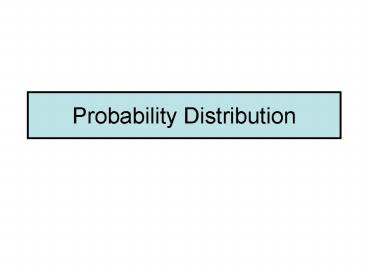Probability Distribution PowerPoint PPT Presentation
Title: Probability Distribution
1
Probability Distribution
2
Probability Distributions OverviewTo understand
probability distributions, it is important to
understand variables and random variables.
- A variable is a symbol (A,B, x, y, etc.) that can
take on any of a specified set of values. - When the value of a variable is the outcome of a
statistical experiment, that variable is a random
variable.
3
An example will make this clear.
- Suppose you flip a coin two times.
- This simple statistical experiment can have four
possible outcomes HH, HT, TH, and TT. - Now, let the variable X represent the number of
Heads that result from this experiment. The
variable X can take on the values 0, 1, or 2. - In this example, X is a random variable because
its value is determined by the outcome of a
statistical experiment.
4
A probability distribution is a table or an
equation that links each outcome of a statistical
experiment with its probability of occurrence.
- Consider the coin flip experiment described
above. The table below, which associates each
outcome with its probability, is an example of a
probability distribution.
5
Probability distribution of the random variable
X.
x (Number of heads) 0 1 2
P(Xx) 0.25 0.5 0.25
6
Generally, statisticians use a capital letter to
represent a random variable and a lower-case
letter, to represent one of its values
- X represents the random variable X.
- P(X) represents the probability of X.
- P(X x) refers to the probability that the
random variable X is equal to a particular value,
denoted by x. As an example, P(X 1) refers to
the probability that the random variable X is
equal to 1.
7
Uniform Probability Distribution
- The simplest probability distribution occurs when
all of the values that a random variable can take
on occur with equal probability. - This probability distribution is called the
uniform distribution.
8
Examples
- When a fair die is tossed, the outcomes have an
equal probability. - When a fair coin is tossed, the outcomes have an
equal probability.
9
Discrete or continuous
- If a variable can take on any value between two
specified values, it is called a continuous
variable otherwise, it is called a discrete
variable.
PowerShow.com is a leading presentation sharing website. It has millions of presentations already uploaded and available with 1,000s more being uploaded by its users every day. Whatever your area of interest, here you’ll be able to find and view presentations you’ll love and possibly download. And, best of all, it is completely free and easy to use.
You might even have a presentation you’d like to share with others. If so, just upload it to PowerShow.com. We’ll convert it to an HTML5 slideshow that includes all the media types you’ve already added: audio, video, music, pictures, animations and transition effects. Then you can share it with your target audience as well as PowerShow.com’s millions of monthly visitors. And, again, it’s all free.
About the Developers
PowerShow.com is brought to you by CrystalGraphics, the award-winning developer and market-leading publisher of rich-media enhancement products for presentations. Our product offerings include millions of PowerPoint templates, diagrams, animated 3D characters and more.

